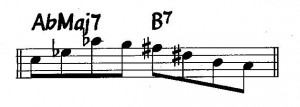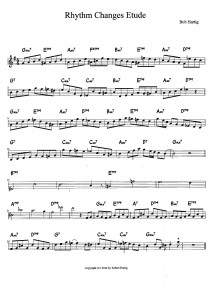My preoccupation with John Coltrane’s tune “Giant Steps” now ebbs, now flows, but always continues. I’m not the most fabulous alto sax man who has ever played the changes, certainly not in the league of Kenny Garrett, but I have my own approach, which I strive to make less digital and more lyrical. I’ve even had the temerity to write a book of licks and patterns on “Giant Steps” titled The Giant Steps Scratch Pad, available for instruments of every key.
In the following video tutorial, I share a couple approaches to practicing the Giant Steps cycle that I have found profitable in my own practice sessions. The video begins with a bit of theory; however, the theory behind “Giant Steps” is more than adequately covered elsewhere in greater depth, as in this excellent article by Dan Adler, and it isn’t the thrust of the tutorial. Rather, I address a more pragmatic concern: How do you wrap your fingers around the Giant Steps cycle? The tips I share in the tutorial certainly aren’t the only way you can or should tackle the cycle, but I think you’ll find them helpful. Briefly, I explain how to run both a one-bar pattern and a more extensive two-bar lick through the cycle.
The two patterns used in the video were taken from The Giant Steps Scratch Pad. For your convenience, I’m supplying them for you here. Note that these excerpts are from the Eb edition, suitable for alto and baritone saxophonists; if you play a C, Bb, or bass clef instrument, you’ll need to transpose (though editions of my book are available in your key). Click on the images to enlarge them.
One-bar pattern:
One-bar pattern through the cycle:
![]()
Two-bar lick through all three keys of the cycle:

And now, here is the video. It’s obviously a homespun effort, so please bear with its flaws. I haven’t figured out how to read from my PowerPoint notes and still look directly at the camera, and as for that stupid deer fly that lands on my forehead while I’m signing off and roams around like an astronaut exploring the lunar surface, I wasn’t aware of it till I got home and viewed the clip. You think I’m going to do a redo just for that? It’s part of filming outdoors: mosquitoes setting up drilling operations on my nice, pink flesh, deer flies exploring my noggin—I deal with it and you can too.
Go ahead and chuckle. But if you’re a jazz improviser who’s tackling “Giant Steps,” then I think you’ll nevertheless find this tutorial worth your while.



